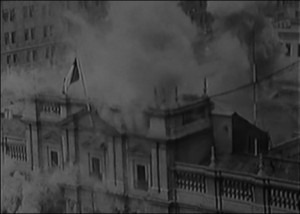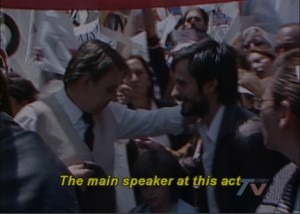In Pablo Larraín’s most recent film No, René (Gabriel García Bernal) looks on as Pinochet’s opposition presents a proposal as to how to fill their allotted time on national TV. They have fifteen minutes each day for a month to make their case for voting “no” in Pinochet’s re-election. Their proposal begins with images of the bombing of Allende’s presidential palace by the air force; it focuses on reportage footage of the harsh violence of Pinochet’s coup itself, brutality in the streets, prisoners of war being taken away. René— an ad man who is expert in manipulating the fizzy montage of commercials, music videos and cheesy 80s comedies— responds blank-faced: “Is that all you got?”

I just watched three of the four discs included in Patricio Guzmán’s The Battle of Chile, a documentary project of incredible scope that covers: in the first disc, the build-up to Pinochet’s ousting of Allende; in the second, a narrative more focused on the violence of the coup itself; and in the third, a broader reflection on the factions that valiantly resisted the military dictator’s rise. The expansive documentary begins with the same image that No’s René watches in the room with the opposition— the bombing of Allende’s palace. René is unimpressed, and his critique is simple: this doesn’t “sell.” Instead, what René ultimately comes up with is a delicious confection: a montage of jokes, a cheesy chorus of Chilean stars singing in unison, all sorts of footage— of mimes even— that seems canned. He pitches his proposal for the “no” spot in the exact same way he pitches a soda commercial: this is “in line with the current social context […] the country is ready for a communication of this nature.” René replaces real documentary footage (Guzmán is a point perhaps for Larraín’s reference) with non-stop jingles and smiles.
The interplay between a “documentary” style in the vein of Guzmán and “light” advertising is elaborated throughout No. The film is entirely shot using vintage 1980s video equipment, which allows Larraín to cut seamlessly between archival footage of the historical moment (news reports) and the performance of his actors with no change in the look and feel of the film/video stock. Everything is present as being equally “real.” The coup de grace is when René— now working for the promotional campaign of a new soap opera— stages a news “event” using the actors of a new series dressed in James Bond-esque gear; he has infiltrated the national news broadcasts with his advertising games. The news becomes just another possible vehicle for ads.


Guzmán’s documentary, from the entirely opposite direction, reveals a similar slippage between an event and its “documentary” representation in film/news/television. In part one, Guzmán captures footage on the streets during the 1973 parliamentary election (effectively a referendum on Allende’s Unidad Popular plurality), which yields the rise of a fiercely bitter bourgeois opposition. Guzmán’s cameramen roam the streets asking people “Who do you think is going to win?” and “What do you think will happen to Chile in the future?” This is typical news journalism; asking random people on the street simple questions, and splicing them together. But somehow, probably because the atmosphere is so charged, the documentary footage becomes something more than what I am used to seeing on CNN/MSNBC or what-have-you. Pauline Kael writes in an essay from the New Yorker included in the Icarus Films boxset, “Guzmán and his associates have taken a relentlessly non-aesthetic approach, yet with their artistic sensibilities and superb taste [the film] is an elegy in spite of them.” The news becomes transformed beyond just simply a recording of the events taking place, particularly when you sense that the person behind the camera feels opinionated about something. Kevin Greeney has written about a similar effect in the work of Chris Marker (who helped produce this film): “What […] causes the image to tremble is the hand of the cameraman and what is occurring in the heart and mind of that interlocutor” (7).
Two examples:
1) Guzmán’s crew is filming a rally of the opposition, and suddenly a woman jumps in to the interview and starts to pointedly attack Allende and warn that, after the results of these elections, the opposition will throw Allende out. As she is talking, the camera takes on a life of its own, zooming in closer and closer to her mouth.

2) The shot during the violence of the first coup attempt when the military troops being filmed by Guzmán’s cameraman, suddenly return his gaze—a moment reminiscent of Hitchcock’s Rear Window when Jimmy Stewart’s character Jefferies realizes he’s being watched. The sequence culminates with the military taking aim with their guns at the cameramen and the camera is shot. We see the camera roll into an out-of-focus gray as it falls.

Larraín’s film shows how the news can be infiltrated by an ingenious advertising construction, but the opposite is equally possible. Real life can be so impactful that begins to affect the character and aesthetic of the art-product.
